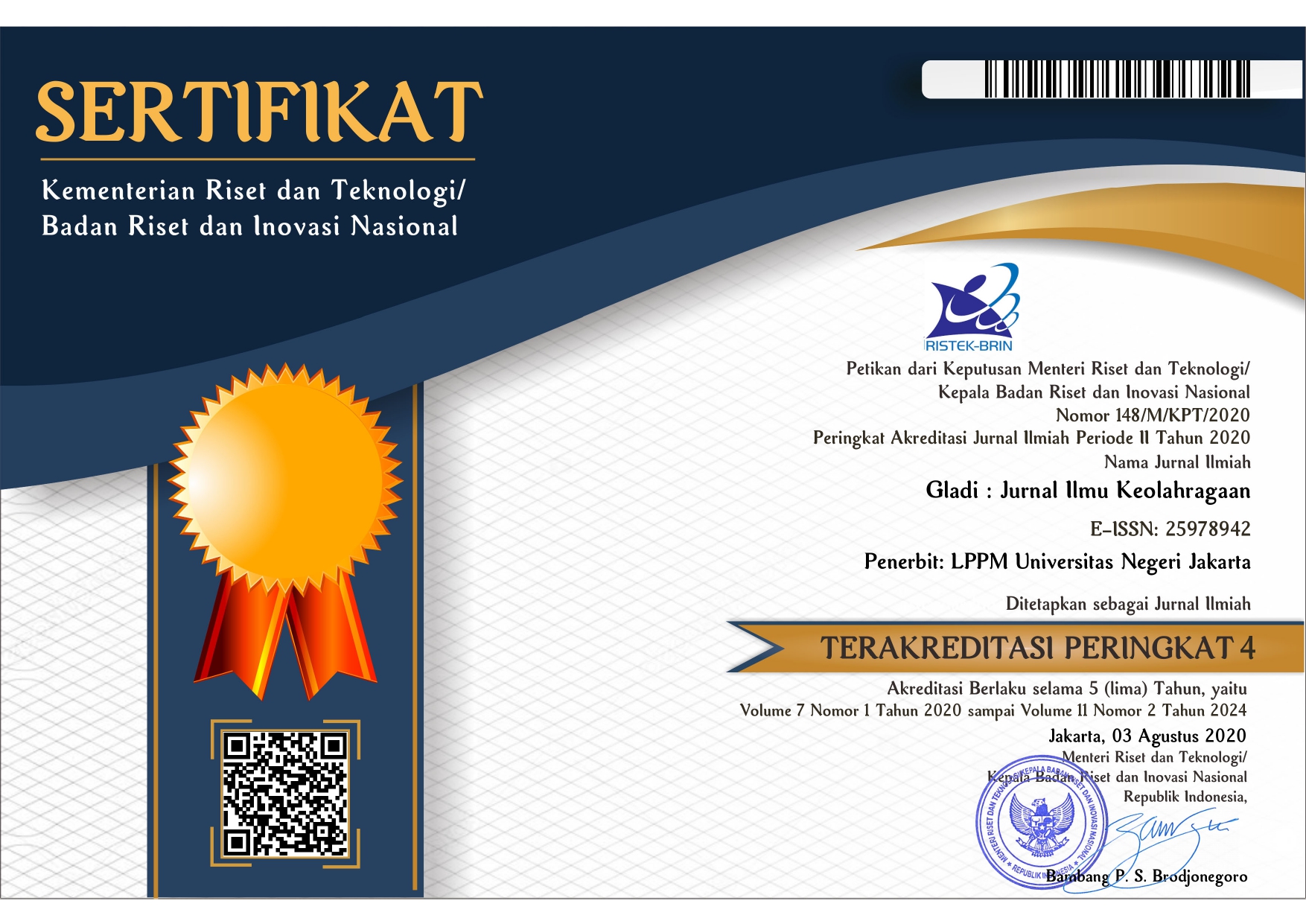Motivation And Commitment Young Children's Swimming Training
Keywords:
Training commitment; Motivation; Sport Psychology; SwimmingAbstract
Swimming athletes must be committed to their training, especially those who are still young. However, not all young swimmers are entirely committed to their training. As a result, the purpose of this study is to link a young swimmer’s motivation with a commitment they make throughout training. The quantitative descriptive method was utilized in this study, and data was collected utilizing total sampling procedures. The population and sample used were young swimmers aged 13–17, while the indicators used were the adoption of the sport commitment scale and motivation level. The Pearson correlation test yielded Sig results. (2-tailed) = 0.625, which is larger than 0.05, indicating that the two variables are unrelated. The conclusion is that a swimmer’s training commitment is not necessarily determined by their motivation. Because the majority of these young swimmers are self-motivated, they are less likely to develop burnout during training.
Downloads
References
Coutinho, P., Ribeiro, J., da Silva, S. M., Fonseca, A. M., & Mesquita, I. (2021). The Influence of Parents, Coaches, and Peers in the Long-Term Development of Highly Skilled and Less Skilled Volleyball Players. Frontiers in Psychology, 12(April), 1–10. https://doi.org/10.3389/fpsyg.2021.667542
Katanic, B., Bjelica, D., Corluka, M., Preljevic, A., & Osmani, A. (2022). Motivational Structure for Sports Practice during COVID-19 Pandemic in Professional Football Players. Sport Mont, 20(3), 127–131. https://doi.org/10.26773/smj.221020
Komarudin. (2016). Psikologi Olahraga. PT. Remaja Rosdakarya.
Komarudin, K., Mulyana, B., & Novian, G. (2021). The Effect of Life Kinetik Training Models to Improve Self-Confidence in Team and Individuals Athletes. The Open Psychology Journal, 14(1), 220–226. https://doi.org/10.2174/1874350102114010220
Larson, H. K., McHugh, T. L. F., Young, B. W., & Rodgers, W. M. (2019). Pathways from youth to masters swimming: Exploring long-term influences of youth swimming experiences. Psychology of Sport and Exercise, 41(July 2018), 12–20. https://doi.org/10.1016/j.psychsport.2018.11.007
Larson, H. K., Young, B. W., McHugh, T. L. F., & Rodgers, W. M. (2019). Markers of early specialization and their relationships with burnout and dropout in Swimming. Journal of Sport and Exercise Psychology, 41(1), 46–54. https://doi.org/10.1123/JSEP.2018-0305
Leyton-Román, M., de la Vega, R., & Jiménez-Castuera, R. (2021). Motivation and Commitment to Sports Practice During the Lockdown Caused by Covid-19. Frontiers in Psychology, 11(January). https://doi.org/10.3389/fpsyg.2020.622595
Mawardi, M. (2019). Rambu-rambu Penyusunan Skala Sikap Model Likert untuk Mengukur Sikap Siswa. Scholaria: Jurnal Pendidikan Dan Kebudayaan, 9(3), 292–304. https://doi.org/10.24246/j.js.2019.v9.i3.p292-304
McLaren, C. D., Newland, A., Eys, M., & Newton, M. (2017). Peer-Initiated Motivational Climate and Group Cohesion in Youth Sport. Journal of Applied Sport Psychology, 29(1), 88–100. https://doi.org/10.1080/10413200.2016.1190423
McLoughlin, G., Fecske, C. W., Castaneda, Y., Gwin, C., & Graber, K. (2017). Sport participation for elite athletes with physical disabilities: Motivations, barriers, and facilitators. Adapted Physical Activity Quarterly, 34(4), 421–441. https://doi.org/10.1123/apaq.2016-0127
Negara, F. B., Yarmani, Y., & Nopiyanto, Y. E. (2021). Pengetahuan Psikologi Olahraga Pada Pelatih Renang dengan Prestasi Atlet Renang Di Rejang Lebong. SPORT GYMNASTICS : Jurnal Ilmiah Pendidikan Jasmani, 2(2), 228–239. https://doi.org/10.33369/gymnastics.v2i2.16196
Pons, J., Viladrich, C., Ramis, Y., & Polman, R. (2018). The mediating role of coping between competitive anxiety and sport commitment in adolescent athletes. Spanish Journal of Psychology, 21, 1–8. https://doi.org/10.1017/sjp.2018.8
Pulido, J. J., Sánchez-Oliva, D., Sánchez-Miguel, P. A., Amado, D., & García-Calvo, T. (2018). Sport commitment in young soccer players: A self-determination perspective. International Journal of Sports Science and Coaching, 13(2), 243–252. https://doi.org/10.1177/1747954118755443
Sánchez-Miguel, P. A., Chow, G. M., Sousa, C., Scanlan, T. K., Ponseti, F. J., Scanlan, L., & García-Mas, A. (2019). Adapting the Sport Commitment Questionnaire-2 for Spanish Usage. Perceptual and Motor Skills, 126(2), 267–285. https://doi.org/10.1177/0031512518821822
Santi, G., Bruton, A., Pietrantoni, L., & Mellalieu, S. (2014). Sport commitment and participation in masters swimmers: The influence of coach and teammates. European Journal of Sport Science, 14(8), 852–860. https://doi.org/10.1080/17461391.2014.915990
Saputra, M. Y., Subarjah, H., Komarudin, K., Hidayat, Y., & Nurcahya, Y. (2022). Psychological Skill Training Implementation to Improve Football Referee Decision-Making Skills. Jurnal Pendidikan Jasmani Dan Olahraga, 7(1), 81–89. https://doi.org/10.17509/jpjo.v7i1.44849
Sheehan, R. B., Herring, M. P., & Campbell, M. J. (2018). Associations between motivation and mental health in sport: A test of the hierarchical model of intrinsic and extrinsic motivation. Frontiers in Psychology, 9(MAY). https://doi.org/10.3389/fpsyg.2018.00707
Taherdoost, H. (2019). What Is the Best Response Scale for Survey and Questionnaire Design; Review of Different Lengths of Rating Scale / Attitude Scale / Likert Scale. International Journal of Academic Research in Management (IJARM), 8(1), 2296–1747.
Teixeira, D. S., Pelletier, L. G., Monteiro, D., Rodrigues, F., Moutão, J., Marinho, D. A., & Cid, L. (2020). Motivational patterns in persistent swimmers: A serial mediation analysis. European Journal of Sport Science, 20(5), 660–669. https://doi.org/10.1080/17461391.2019.1675768
Thomas, A., & Güllich, A. (2019). Childhood practice and play as determinants of adolescent intrinsic and extrinsic motivation among elite youth athletes. European Journal of Sport Science, 19(8), 1120–1129. https://doi.org/10.1080/17461391.2019.1597170
Webb, E., & Forrester, S. (2016). Peer-created Motivational Climates: Variations in the Perceptions of Collegiate Intramural Sport Participants. International Journal of Sport Management, Recreation & Tourism, 23(January), 22–50. https://doi.org/10.5199/ijsmart-1791-874X-23b







